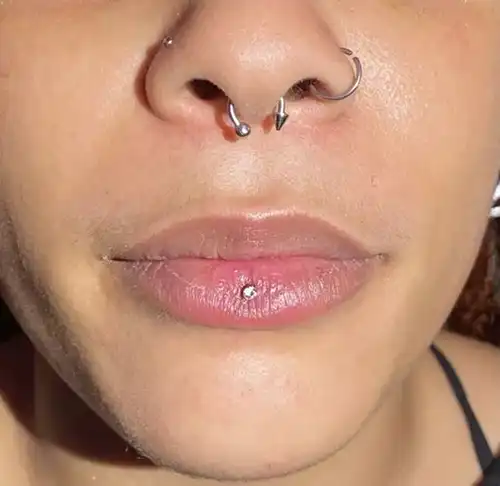Ashley Piercing in Nairobi, Kenya
The Ashley Piercing is a type of lip piercing where a single puncture is made through the center of the bottom lip, with the jewelry exiting on the inner side of the lip. It’s a bold and eye-catching style that emphasizes the lip, making it a popular choice for those who want a unique and striking facial piercing.
Ashley Piercings
Key Details About Ashley Piercing:
- Procedure: A professional piercer uses a sterilized needle to create the piercing. It’s essential to ensure proper alignment and placement.
- Jewelry: Typically, a flat-back labret stud is used. The jewelry’s size and material (e.g., titanium, surgical steel) are chosen to minimize irritation and promote healing.
- Healing Time: Healing usually takes 8 to 12 weeks, though it may vary depending on individual aftercare practices.
- Aftercare:
– Clean the area twice daily with a saline solution or a piercer-recommended cleaning product.
– Avoid touching the jewelry with unclean hands.
– Refrain from consuming spicy or acidic foods during the initial healing period to prevent irritation.
– Do not remove or change the jewelry until the piercing is fully healed. - Pain Level: Pain is subjective, but this piercing is generally rated as moderately painful because it involves thicker tissue than some other types of piercings.
- Risks:
– Swelling, redness, or irritation in the early stages is common but should subside with proper care.
– Potential for scarring or gum/tooth damage if improperly placed or cared for.
Ashley Piercing Procedure
The Ashley Piercing is a specialized lip piercing, and it’s crucial to have it done by a professional piercer to ensure safety and accuracy. Here’s a step-by-step guide to how the procedure is typically performed:
Step 1: Consultation and Preparation
- Consultation:
– Our piercer discusses your preferences, explains the procedure, and evaluates your lip anatomy to ensure suitability.
– Jewelry options are presented, usually focusing on flat-back labret studs made of biocompatible materials like titanium or surgical steel. - Preparation:
– You are seated comfortably, and the area around your mouth is cleaned and disinfected.
– A mouth rinse with a non-alcoholic antiseptic is usually provided to reduce bacteria inside the mouth.
Step 2: Marking and Approval
Our piercer marks the entry point on the center of the lower lip’s outer surface and the exit point on the inner surface. You’ll be shown the marks in a mirror to confirm placement.
Step 3: Piercing the Lip
- Sterilized Needle: Our piercer uses a hollow, sterilized needle to puncture the lip through the marked points. This is done swiftly and accurately to minimize discomfort.
- Insertion of Jewelry:
– The chosen jewelry (usually a labret stud) is inserted immediately through the fresh piercing.
– Our piercer ensures the jewelry is the correct length to accommodate swelling during the healing phase.
Step 4: Cleaning and Aftercare Instructions
Our piercer cleans the area again to remove any blood or residue. Detailed aftercare instructions are provided, including cleaning routines, what to avoid, and when to return for a check-up.
Things to Expect:
- Pain Level: Moderate; it’s quick, but the thicker tissue of the lip may cause more discomfort compared to piercings like ear lobes.
- Swelling: Common in the first few days; our piercer usually selects jewelry with extra length to allow for this.
- Healing Time: Approximately 8-12 weeks, but complete healing can take longer.
Considerations before getting an Ashley Piercing
- Piercing Studio Selection: Research reputable piercing studios in your area. Look for studios with experienced, professional piercers who follow strict hygiene and safety practices.
- Piercer’s Qualifications: Ensure that the piercer is trained, licensed, and experienced in performing Ashley piercings. Ask to see their portfolio of previous work.
- Healing Time: Understand that piercings take time to heal. Ashley piercings, like other lip piercings, can take several weeks to several months to fully heal.
- Pain and Swelling: Be prepared for some pain and swelling after the piercing. Lip piercings can be uncomfortable during the initial healing period.
- Jewelry Options: Discuss jewelry options with your piercer. Choose high-quality jewelry made from materials such as surgical steel, titanium, or biocompatible materials to reduce the risk of allergic reactions.
- Infection Risk: Understand the risk of infection and other complications. Proper aftercare is essential to minimize these risks.
- Oral Health: Lip piercings, including Ashley piercings, can potentially affect oral health. Be mindful of how the piercing may interact with your teeth and gums.
- Lifestyle Considerations: Consider your lifestyle and how the piercing may impact daily activities, such as eating, speaking, and kissing. Lip piercings can affect these functions temporarily.
- Allergies: Inform your piercer of any known allergies or sensitivities you have to certain metals or materials to ensure safe jewelry selection.
- Aftercare Commitment: Be prepared to follow the aftercare instructions provided by your piercer diligently. Proper cleaning and care are crucial for a successful healing process.
- Potential Removal: Understand that you may need to remove the piercing in certain situations, such as for medical or dental procedures, and be prepared for this possibility.
- Long-Term Commitment: Piercings are a commitment, and you should be prepared to keep the jewelry in place for an extended period if you want to maintain the piercing’s appearance.
- Consultation: Before getting the piercing, have a consultation with your chosen piercer to discuss your expectations, ask any questions, and receive personalized advice.
It’s crucial to weigh these considerations carefully and have an open and honest discussion with your piercer before getting an Ashley piercing or any other piercing. Remember that everyone’s body and healing process are unique, so results and experiences can vary from person to person. Make sure you are fully informed and comfortable with the decision before proceeding.

Ashley Piercings FAQ’s
Pain and Healing for an Ashley Piercing
Pain Level
- Moderate Pain: The Ashley piercing involves puncturing the lower lip, which has thicker tissue and many nerve endings, making it more painful than some other piercings (like earlobes).
- Pain varies based on individual tolerance but is often described as a sharp pinch during the piercing process, followed by mild throbbing for a few hours afterward.
- A skilled piercer can minimize discomfort by working quickly and accurately.
Healing Process
The healing time for an Ashley piercing typically ranges from 8 to 12 weeks, but complete healing may take up to 6 months for some people.
- Initial Phase (1-3 weeks):
– Swelling, tenderness, and slight redness are normal.
– The jewelry might feel tight due to swelling. - Mid-Healing Phase (3-8 weeks):
– Swelling decreases, and the tissue begins to form around the jewelry.
– Minor crusting (a mix of lymph fluid and skin healing) is normal and can be gently cleaned. - Final Healing Phase (8-12 weeks):
– The piercing fully heals, and the jewelry should feel comfortable.
– No pain or discomfort should be present.
Tips for Pain Management
- Take an over-the-counter pain reliever like ibuprofen to reduce pain and swelling during the first few days.
- Apply a cold compress (wrapped in a clean cloth) to the outside of your lip to minimize swelling.
- Stay hydrated and avoid irritating foods (spicy, acidic, or salty) to prevent additional discomfort.
Signs of Healing Issues
- Persistent redness, swelling, or pain beyond the first 1-2 weeks.
- Unusual discharge (thick, yellow, or green pus) or a foul smell.
- Bumps or irritation from improper jewelry placement.
If these occur, Contact Our Piercer immediately.
Ashley Piercing Aftercare Guide
Proper aftercare is essential for ensuring the Ashley piercing heals quickly and without complications. Here’s a detailed guide to help you maintain your piercing during the healing process.
Cleaning Routine
- Twice Daily Cleaning:
– Use a sterile saline solution (or a piercing aftercare spray) to clean the outside of the piercing.
– Gently pat the area dry with a clean, disposable tissue or paper towel. Avoid using cloth towels, as they can harbor bacteria. - Mouth Rinse:
– Rinse your mouth with a non-alcoholic, antimicrobial mouthwash after eating or drinking anything other than water.
– Alternatively, a homemade saline solution (1/4 teaspoon of non-iodized sea salt in 1 cup of warm water) can be used for rinsing. - Crust Removal: If crust forms around the jewelry, soak the piercing with a saline solution for a few minutes to soften it before gently cleaning.
Lifestyle Adjustments
- Avoid Touching: Do not touch, twist, or play with the jewelry. This can introduce bacteria and delay healing.
- Dietary Changes: Avoid spicy, acidic, or salty foods during the initial healing period to prevent irritation.
- Hydration: Drink plenty of water to keep your lips hydrated and aid healing.
- Smoking & Alcohol: Refrain from smoking and consuming alcohol, as these can irritate the piercing and slow healing.
Jewelry Care
- Leave the initial jewelry in place for the entire healing period (8-12 weeks). Premature removal can lead to irritation or closure of the piercing.
- Ensure the jewelry is made from hypoallergenic materials like titanium, surgical steel, or bioplast to minimize allergic reactions.
What to Avoid
- Makeup and Skincare Products: Avoid applying lipstick, lip balm, or facial products near the piercing.
- Swimming: Avoid pools, hot tubs, and natural bodies of water during the healing phase to prevent infection.
- Oral Contact: Avoid kissing or oral activities that could expose the piercing to bacteria.
Healing Tips
- Expect swelling for the first 3-5 days; a longer bar is used to accommodate this. Return to your piercer for resizing if swelling subsides before healing completes.
- Take an over-the-counter anti-inflammatory (like ibuprofen) to reduce swelling if necessary.
Signs of Healing Problems
- Infection: Look for symptoms like excessive redness, swelling, yellow or green discharge, and pain that worsens over time.
- Jewelry Irritation: If the jewelry feels too tight or embedded, consult your piercer for advice.
- Rejection or Migration: Unusual movement of the jewelry or thinning skin around the piercing may indicate rejection.
When to Seek Help
If you suspect an infection, experience prolonged swelling or pain, or have concerns about the piercing, Consult Our Piercer immediately.
Ashley Piercing Jewelry Guide
Choosing the right jewelry for an Ashley piercing is critical to ensure comfort, proper healing, and style. Here’s an overview of jewelry types, materials, and considerations for an Ashley piercing:
Jewelry Type
- Flat-Back Labret Stud:
– The most common and recommended type of jewelry for Ashley piercings.
– Features a flat disc on the inside of the lip, which minimizes irritation to the gums and teeth.
– The decorative end (e.g., a gem, ball, or charm) is visible on the outside. - Length and Size:
– Initially, a slightly longer bar is used to accommodate swelling.
– Once the piercing heals (8-12 weeks), you can downsize to a shorter bar for better comfort and aesthetics.
Jewelry Materials
Choosing high-quality, hypoallergenic materials reduces the risk of irritation or allergic reactions. Common options include:
- Titanium:
– Lightweight and hypoallergenic.
– Ideal for those with sensitive skin or metal allergies. - Surgical Steel:
– Durable and affordable.
– Slightly heavier than titanium but safe for most people. - Niobium:
– Hypoallergenic and corrosion-resistant.
– A good alternative to titanium for sensitive skin. - Gold (14k or 18k):
– A stylish option for healed piercings.
– Avoid gold-plated jewelry during healing, as it can flake and cause irritation. - Bioplast or PTFE (Flexible Plastic):
– Great for individuals needing flexibility (e.g., athletes).
– Safe for healing and very lightweight.
Jewelry Styles
- Minimalist:
– Smooth, polished ends for a sleek look.
– Ideal for professional or understated settings. - Decorative:
– Gemstone or charm ends for added flair.
– Popular options include opals, crystals, or intricate designs. - Custom Designs: Personalized styles are available for healed piercings.
Changing the Jewelry
- Initial Healing Phase: Do not change the jewelry for at least 8-12 weeks or until the piercing is fully healed.
- Downsizing: Visit your piercer to switch to a shorter bar once swelling subsides to prevent irritation.
- Professional Assistance: Always seek help from a professional piercer when changing jewelry during or shortly after healing.
Jewelry Care
- Clean jewelry regularly with warm water and mild soap, especially for healed piercings.
- Ensure threads (if any) are securely fastened to prevent accidental loss.
Cost of a Ashley Piercing in Nairobi, Kenya
The cost of an Ashley piercing varies depending on factors such as the studio’s location, the piercer’s experience, and the type of jewelry used. Here’s a general breakdown:
Average Cost
Typically Ksh. 1,500 – Ksh. 2,5000 depending on the studio and jewelry.
Factors Influencing Cost
- Piercer’s Experience: Highly experienced or renowned piercers often charge more for their expertise. At Rebel Inks Tattoos, Tattoo Removal, and Body Piercings Parlour we have experienced professionals who offer quality and premium services.
- Studio Reputation: Premium studios with high hygiene standards and certifications may charge higher fees.
- Jewelry Selection:
– Standard surgical steel jewelry is included in most base prices.
– Upgrades to titanium, gold, or gemstone jewelry increase the cost. - Location: Piercing prices are generally higher in urban areas or upscale neighborhoods. Rebel Inks Tattoos, Tattoo Removal, and Body Piercings Parlour is located in the heart of the Central Business Disrict (CBD) in Nairobi, Kenya, and is easily accessible to both locals and foreigners in the country.
- Aftercare Products: Some studios include aftercare kits in the price, while others may charge separately.
Price Breakdown by Category
Category | Estimated Cost (KSh) | Details |
Procedure | 2,500 – 4,000 | Angel Bites piercing including both sides |
Single Side (Monroe/Madonna) | 1,500 – 2,000 | If done individually |
Basic Jewelry (Steel/Titanium) | Included or 500 – 1,000 | Usually included in full package; cost depends on material |
Premium Jewelry (Gold/Gem) | 1,000 – 3,000 | Optional upgrade to high-end or aesthetic pieces |
Aftercare Kit (Saline, Balm) | 300 – 500 | Sometimes included; helps in faster healing |
Consultation or Touch-Up Fee | 0 – 500 | Charged in some studios for check-ups or change of jewelry |
Additional Costs
- Jewelry Changes: Downsizing or upgrading jewelry after healing can cost an additional Ksh. 500 – Ksh. 1,000.
- Touch-Ups or Consultations: Follow-up appointments for issues like resizing or irritation may have additional fees.
Tips for Clients
- Always prioritize quality and hygiene over cost when choosing a studio.
- Inquire if the price includes aftercare instructions or products.
- Avoid studios offering significantly low prices, as this may indicate compromised quality or hygiene.
Possible Side Effects of an Ashley Piercing
While an Ashley piercing can heal beautifully with proper care, it’s important to be aware of potential side effects and how to manage them. Here’s a comprehensive guide:
Common Side Effects
- Swelling:
– Expected in the first few days after piercing.
– Usually subsides within a week with proper aftercare, such as cold compresses and anti-inflammatory medication. - Pain or Tenderness:
– Mild to moderate pain is normal during the initial healing phase.
– Persistent or worsening pain could indicate an issue. - Redness and Minor Irritation:
– Slight redness around the piercing is common, especially during cleaning or movement.
– Should reduce as the piercing heals.
Potential Complications
- Infection:
– Symptoms: Persistent swelling, warmth, redness, yellow or green discharge, and foul odor.
– Prevention: Maintain strict aftercare, avoid touching, and use clean utensils when eating.
– Action: Consult a piercer or healthcare professional for treatment. - Jewelry Rejection or Migration:
– The body may push the jewelry out over time, leading to migration or rejection.
– Caused by improper jewelry type, placement, or individual anatomy.
– Prevention: Choose high-quality, lightweight jewelry and a skilled piercer. - Scarring or Keloids:
– Excessive scarring can occur if the piercing is irritated or improperly cared for.
– Prevention: Avoid picking at the piercing or changing jewelry prematurely. - Gum and Tooth Erosion:
– Jewelry rubbing against gums or teeth can cause irritation, receding gums, or enamel wear.
– Prevention: Properly sized and placed jewelry, such as flat-back labret studs.
Allergic Reactions
- Metal Allergies: Symptoms include itching, redness, or rash around the piercing.
- Prevention: Use hypoallergenic materials like titanium or niobium.
Rare Side Effects
- Lip Tissue Trauma:
– Caused by snagging or excessive movement of jewelry.
– Prevention: Avoid playing with the jewelry and be cautious when eating or dressing. - Prolonged Healing:
– Healing time may extend if the piercing is irritated or infected.
– Prevention: Adhere strictly to aftercare and avoid irritants like smoking.
When to Seek Help
- Persistent pain, swelling, or redness lasting more than 10 days.
- Fever or systemic symptoms (indicative of a severe infection).
- Sudden changes in jewelry fit (e.g., embedding or extreme looseness).
Related Piercing
Get In Touch
For more information on the list above and any other special services,please call or come in for free consultation
Testimonials
After he pierced my industrial piercing and seeing his amazing work, I feel even more excited about getting my tattoo with him in January. I’m really looking forward to it!
I am extremely happy with my new 'Safari' tattoo from Eric at Rebel Inks! The quality of the artwork is fantastic. Eric is a true professional and an amazing artist.
The preparation and design process was thorough and collaborative. He was very patient with my specific requests, including making sure all the elements, which hold personal meaning, were perfect.
The service was friendly and highly professional from start to finish. Despite the 8-hour session, Eric was a pleasant person to spend the time with.
The aftercare guidance and follow-up have been excellent and careful, which has made the healing process easy and better than expected.
I highly recommend Eric for anyone looking for a thoughtful, talented, and caring tattoo artist.
I recommend them 💯
I would definitely recommend if you’re thinking of getting a piercing!
The staff were super friendly, explained everything clearly, and made me feel so at ease. They answered all my nervous questions (and I had many questions),
They walked me through the whole process, gave detailed aftercare instructions, and even followed up afterward to check how I was healing 🫶
Clean, professional, and full of good vibes.
Would 100% recommend . Definitely making a second trip here.
This was the second tattoo I got and I wish I could have come to Eric for my first one! He gave me really great after-care directions for the tattoo as well as a little jar of his own Vaseline-type stuff to put over my tattoo while it was healing! He even put second skin over my tattoo so that I didn’t have to worry about it for the first few days. Now THAT’S good service. My first tattoo artist didn’t do none of that lol.
After the session Eric didn’t rush me and my friend out, he chatted with us and even when he found out I was an artist too— really encouraged me to keep creating and to find a community of artists to support me. I almost cried because I’ve had such a hard time with my own art the past couple of years, it meant so much to me to have a fellow very talented artist say that to me. 🤍🤍🤍
Eric you’re amazing, don’t ever stop creating and just know you’ve impacted lives all over the world!🫶🏻 thanks so much for everything!!
From the moment I walked in, Eric was professional, welcoming, and attentive. He made sure I was comfortable throughout, provided everything I needed, and explained every step of the process. The tattooing itself was unbelievably smooth - I genuinely felt no pain compared to my previous tattoos over the last 22 years.
Eric also gave me excellent aftercare guidance and products, and thanks to that, my tattoo healed beautifully. The attention to detail, precision, and shading are absolutely stunning. This is hands-down the best tattoo I've ever had, and I will be flying back to Nairobi for any future ink.
If you want incredible art, a professional experience, and a talented artist who truly cares about his clients, Rebel Ink is the place to go!
From start to finish, the service was exceptional. The piercer was professional, knowledgeable, and made me feel completely comfortable. The cleanliness of the place was above and beyond — everything was spotless and hygienic, which really put me at ease. Highly recommend for anyone considering a piercing!
Shout out to Eric😘
We ended up changing the jewelry three times to ensure I had the best fit and avoided any signs of rejection, and he always listened to my suggestions as a client, which I really appreciated. Now, three months in, my piercing is healing beautifully, with no sign of rejection. Highly recommend for anyone who values a piercer who cares about your comfort and healing journey!
What stood out the most was the aftercare Eric checked in with me even three weeks later to see how the tattoo was healing. That kind of follow-up shows how much he truly cares about his work and his clients.
I’m very satisfied and will definitely be coming back for my next piece. Highly recommend!
The piercing wasn't as painful as I had thought and the process was quick and satisfactory. I love it!!!
The piercing is healing well thanks to the aftercare instructions and follow-up. I would highly recommend Rebel Inks
Eric also did a belly button piercing for a friend, guiding her through the process, doing the piercing and then explaining the after care to her.
The shop is on the 3rd floor, with the entrance to the stairs near an alleyway on the left. The shop is perfect size, clean, and attractive looking. The mural is pretty dope.
Thank you for the amazing service! 🔥👅✨
I got piercibgs there and the process was really good. My biggest concern was hygiene but that wasn't an issue at all, they use new needles and they sanitize them.
The service itself was also welcoming.
I was informes of everything i needed to know beforehand.
10/10 would recommend!
Eric was so calm and patient with my almost 2 year old lady. It was such a clean and hygienic process. We will definitely be back for our second rounds of piercings and maybe even another tattoo!
They assess the area before any art and advise one accordingly. They also give one post clean up process and also do a check up after the body art projects. Overall, I loved my experience and I’m hooked. 👍
Will definitely come back next time I’m in town 🙂
He listened to what I actually wanted and made sure he could fit in the time before I flew back home.
The shop is clean & private and is easy enough to find.
Eric has even checked in a couple of times since to make sure all is good.
I would totally recommend Eric! I absolutely love my Elephants!
I had a very easy healing period and always follow up from Eric to check on my progress...I would highly recommend if you are a first timer because from my experience all went very well and attention to detail
Thank you for a good job and looking forward to send all my friends your way
And all the best with the new year 2025!
From the moment I walked in, the staff was super friendly and made me feel at ease. The studio had a clean, professional atmosphere, which immediately put me at ease. My piercer was incredibly skilled and explained every step of the process, ensuring I was comfortable the entire time. The piercing was quick and practically painless, and the aftercare instructions were clear and easy to follow. I can tell they really care about the health and safety of their clients.
Overall, a fantastic experience—I highly recommend Rebel Inks and Tattoos for anyone looking to get pierced or tattooed!
They do follow up after their services
Eric's Studio isn’t just a place to get a tattoo—it’s an experience. The combination of professionalism, artistic talent, and a welcoming environment makes it a standout destination for anyone considering a tattoo.
I highly recommend Eric’s Studio to both first-timers and seasoned tattoo enthusiasts. If you’re looking for a high-quality tattoo and an enjoyable experience, this is the place to go.
I would definitely recommend their services again and again
Thank you Rebel Ink
My piercings are healing ❤️🩹 well
I would 💯 recommend
I will definitely come back for more .
Two, all the equipments he used for the piercings were new and/or sterilised.
Three, the parlour itself was very clean and was up to par with the hygiene standards.
Four, Eric provided effective aftercare instructions, making sure I knew exactly how to take care of my new piercings and he kept in touch and continues to do so, to check on the healing progress.
I highly highly highly recommend this place!!!
Would definitely recommend them to friends and go back for other piercings
Not only was the piercing process smooth, but he also provided thorough aftercare instructions, making sure I knew exactly how to take care of my new piercings. What really impressed me was that he keeps in touch to check on how the healing is progressing – a sign of true care for his clients.
The shop maintains a high standard of hygiene, and the atmosphere is welcoming and comfortable, which really added to the positive experience. I highly recommend this place to anyone looking for a professional and caring experience. I’ll definitely be coming back for any future piercings!
My appreciation for the excellent customer service I received. The follow-ups were prompt, and I truly appreciated the gentleness and professionalism throughout. Thank you!"
"Looking for professional eyebrow microshading removal? Look no further!"
The customer care is top tier 👌🏾👌🏾.
Wonderful place to get tattoos and piercings. 💯💯
Eric goes ahead to follow up on his clients progress and gives good advice each time I reach out to him.
I would recommend Reble tattoos anytime.
Good job bro we really appreciate.
Ohh and the price is very fair.
The environment was clean , procedure was sterile and the jewelry used are of the best quality.
He followed up with me during the healing process, he educated me on what I needed to do for my aftercare.
Eric is confident, skilled , experienced and the best piercer. Highly recommend Rebel inks.✨
Definitely recommend!
Great experience.
Eric definitely know what he is doing .
I got exactly what I wanted 2 tiny tats on the same finger .
He was kind and patient throughout the session.
Healing process has been good .
Aftercare services were given and regular checkups on the healing process were done.
I would 💯recommend.
Eric gave me the best reception as it was my first time there,and made me trust him all the way. I appreciate good services.
There services are also affordable not to forget 😊.
He was also invested in the aftercare and would ensure I follow the do's and don'ts in taking care of the tattoo and ensuring proper healing and maximum ink retention.
Would highly recommend Rebel Inks Tattoos.
Rebel Inks Tattoo offer the best,affordable and quality tattoo removal services.If you have unwanted ink,choose Rebel Inks Tattoo,they're the best of the best and the professionalism is a top notch.They ensure you're free from unwanted ink with their Laser Tattoo Removal Technology...
I did a Laser Tattoo Removal with them and i can attest they're the best....
Kudos Eric...
I highly recommend.
It was a generally good experience with good hygiene during the piercing process and has been a smooth healing process.... 10/10
tips. Highly recommend 👍🏽
100% recommendable.
I was particularly impressed with Eric's attention to hygiene. He thoroughly cleaned the room before I entered, sanitized all of the equipment he would be using, and changed gloves between each ear. This level of cleanliness gave me great confidence in his professionalism.
Eric's commitment to customer service did not end on the day of the piercing. He followed up with me regularly throughout the healing process to ensure that I was following the aftercare instructions and that my earlobes were healing properly.
I highly recommend Rebel Inks to anyone in Nairobi who is considering getting a piercing. Eric is a highly skilled and experienced piercer who takes great pride in his work.
So I Check all the boxes below and more:
Customer Care: ✔️
Professionalism : ✔️
Cleanliness ✔️
Price: ✔️
After care service ✔️
Thanks and good job, Eric
The place is neat and clean and the equipments he used were also fine standards. Really appreciate his following up with me on the healing 🤗
I WOULD HIGHLY RECOMMEND THEIR SERVICES to everyone. Actually what you see on their website is EXACTLY what you will get. Keep up the good work Rebel inks Tattoos.
The infection is now gone. I would definitely recommend!
Can recommend this place totally and would go back there anytime!
Thanks!
OUR LOCATION
Areas We Serve
NAIROBI
KIAMBU
KAJIADO
MACHAKOS

















































































































































































































